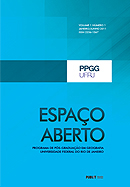Do They Keep Coming? The Emergence of New Spatial Mobility Patterns in Macaé/RJ
DOI:
https://doi.org/10.36403/espacoaberto.2012.2076Keywords:
Spatial mobility, Commuting, Macaé/RJAbstract
Macaé is the “Oil Capital” of Brazil: a city of opportunity, full of jobs and
where royalties fatten public coffers or that is the image presented in the media that has attracted thousands of migrants to Macaé. This study investigated why people feel that migrants keep coming to Macaé even though recent statistics show that in-migration to the city has decreased. Also, new forms of spatial mobility of the population have emerged so that Macaé can be characterized as region of polar attraction. Commuting from neighbouring cities is a common pattern in metropolitan areas and in Macaé it is associated to the high cost of living and violence present there so that many workers have their residence elsewhere, especially Rio das Ostras. In addition to daily commuting, another kind was detected in the research: "long distance commuting". This kind of commuting is associated basically to specific characteristics of the labour market in the oil sector involving periods on the platforms interspaced with periods off duty on the mainland as well as outsourcing practices. A third trend noted was the presence of a significant number of transients, who keep coming to the city in large numbers but do not lay residence.


